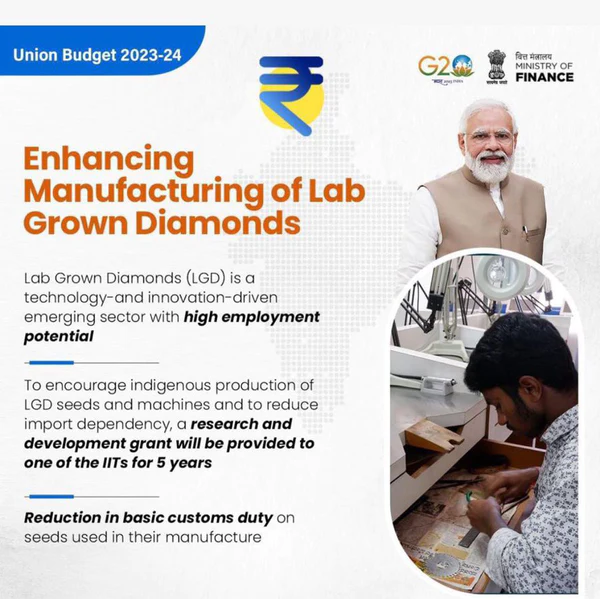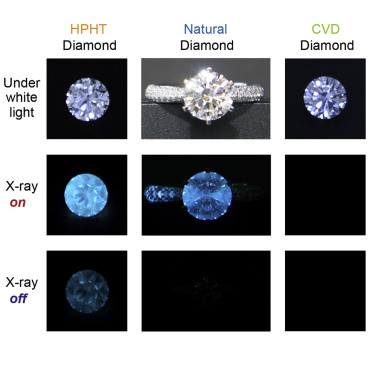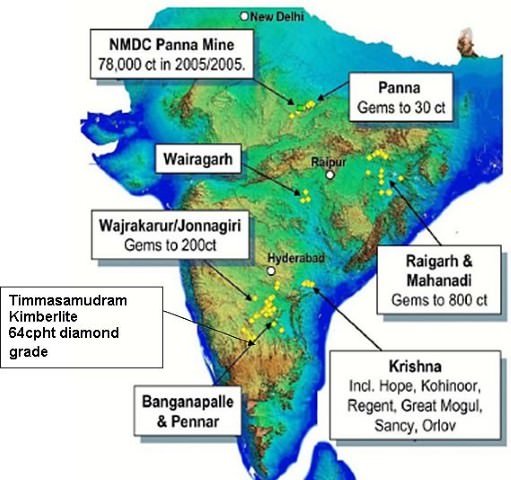Table of contents
The Ministry of Finance (MoF) in its 2023-24 Union Budget has put special emphasis on Laboratory-Grown Diamonds (LGD).

Synthetic diamonds, also known as lab-grown or cultivated diamonds, represent a fascinating blend of technology and gemology. They are identical to natural diamonds in terms of physical, chemical, and optical properties but are produced artificially.
Production Methods
1. High-Pressure High Temperature (HPHT)
- Process: This method replicates the natural diamond-forming conditions found in the Earth's mantle. It involves subjecting carbon to extremely high temperatures and pressures.
- Outcome: The result is diamonds that are structurally and chemically identical to those formed in nature.

2. Chemical Vapor Deposition (CVD)
- Process: Begins with a small diamond seed placed in a chamber. Carbon-rich gases are introduced and heated until they break down, allowing carbon atoms to accumulate on the diamond seed and form a larger diamond.
- Technology: The CVD method is highly controlled and technologically advanced.

Comparison

- Physical Properties
- Similarities: Synthetic diamonds share the same hardness, thermal conductivity, and refractive index as natural diamonds.
- Variations: Minor differences in trace elements and crystal growth patterns.
- Ethical and Environmental Benefits
- Ethical Choice: These diamonds are marketed as a more ethical option, free from the conflicts often associated with natural diamond mining (also known as "blood diamonds").
- Environmental Impact: Their production is less disruptive to the environment compared to traditional diamond mining processes.
- Cost
- Affordability: Generally less expensive than natural diamonds, owing to lower production costs and the absence of mining expenses.
- Market Dynamics: The cost difference is also influenced by the growing acceptance and demand for synthetic diamonds.
Identification
Distinguishing between natural and synthetic diamonds is difficult without specialized equipment, as they are visually and structurally similar to the naked eye.
- Spectroscopy: Infrared, ultraviolet, and visible spectroscopy can detect differences in the absorption and emission of light, revealing specific characteristics of each diamond type.
- Magnetic Resonance Imaging (MRI): Can sometimes distinguish between LGDs and natural diamonds based on differences in their atomic structure.
- Laser Inscription: Many LGDs come with a laser inscription on the girdle of the diamond, indicating their lab-grown origin. However, not all LGDs are inscribed.
- Fluorescence and Phosphorescence: Under UV light, diamonds can exhibit fluorescence. The patterns and colors can differ between natural and synthetic diamonds.

Certification and Analysis
Often, gemological institutes use advanced equipment to certify and identify synthetic diamonds.
- Diamonds (both natural and LGD) are often certified by reputable international and national gemological institutes such as the Gemological Institute of America (GIA), International Gemological Institute (IGI), and Bharat Diamond Bourse (BDB).
- Certificates typically include details about the diamond’s origin, and Indian sellers are expected to provide this documentation upon sale.
The Indian government, through organizations like the Gem & Jewellery Export Promotion Council (GJEPC), has initiatives to ensure the integrity of the diamond trade, including the differentiation between natural and lab-grown diamonds
Applications
- Jewelry: Increasingly popular in the jewelry industry as a cost-effective and ethical alternative.
- Industrial Uses: Valued for their hardness and thermal properties in cutting, grinding, and drilling applications.
- Electronics: Employed in semiconductors for computer chips, satellites, and 5G networks due to their unique properties.
We can't clear UPSC for you.
But with our personalised mentor support, you'll be ready to do it yourself.
Indian diamond industry
- Diamond occurs in two types of deposits, primarily in igneous rocks of basic or ultrabasic composition and in alluvial deposits derived from the primary sources.

- Diamond fields of India are grouped into four regions:
- South Indian tract of Andhra Pradesh,comprising parts of Anantapur, Kadapa,Guntur, Krishna, Mahabubnagar and Kurnool districts;
- Central Indian tract of Madhya Pradesh, comprising Panna belt;
- Behradin-Kodawali area in Raipur district and Tokapal, Dugapal, etc. areas in Bastar district of Chhattisgarh; and
- Eastern Indian tract mostly of Odisha,lying between Mahanadi and Godavari valleys.

- India is the world’s largest cutting and polishing center for diamonds,accounting for over 90% of polished diamond manufacturing globally.India exports more than 75% of the world’s polished diamond, gems and jewellery.
- India depends largely on imports of rough gem diamonds for its Cutting and Polishing Industry as there is no notable production except for one producer in Madhya Pradesh.
- Diamond cutting and polishing is one of the fastest-growing sectors, mostly export-oriented and being labour intensive employs more than 5 million people,contributing around 7% to the country’s GDP and 15% to India’s total merchandise export.
Challenges
- Uncertainty in Supply of Raw Material
- Unorganised Market consisting family owned firms
- Expected Rise in Diamond Prices
- Falling International Demand
- Competition from China
India's Push for Lab-Grown Diamonds (LGD)
Well supported by government policies since it earns foreign exchange, easy availability of high skilled labour, cutting-edge technology and lower costs involved are some attributes.
- Research Grant: The Indian government announced a significant five-year research grant for the indigenous production of LGD.
- InCent-LGD: IIT-Madras is set to establish the India Centre for Lab Grown Diamond with substantial funding.
- Objectives: The project aims to assist the industry and entrepreneurs, boost employment, and increase exports.
- Market Forecast: The global lab-grown diamond market is anticipated to exceed $15 billion by 2035, highlighting its growing significance.
Synthetic diamonds offer a sustainable and ethical alternative in the gemstone market, aligning with modern consumer values and environmental concerns. Their diverse applications across various industries further reinforce their importance in the global market.
Previous Post